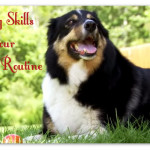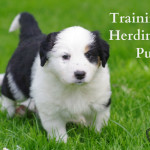What Is the Best Dog Food For Herding Breeds?
Everybody wants to give their dog the best dog food. Owners of herding breeds are especially concerned due to the high energy level of these dogs. Optimum feeding for that competitive edge is also concern for owners of agility and herding canine athletes. What are the optimum ratios of protein, fat and carbohydrate for herding dogs? Actually, there is not a single answer. In some ways “herders” are unique and may need special diets. In other ways they are not unique and special diets are not necessary. Let’s explore.
Exercise Metabolism in Dogs
In an earlier post I discussed the exercise efficiency of all dogs and how few calories they expend for rigorous tasks. This is due in a large measure to their unique muscle structure and metabolism.
Type I (slow twitch) muscle fibers – Type 1 muscle fibers are designed for endurance and use fat and amino acids from protein combined with oxygen for energy. These muscles allow the Herculean efforts of sled dogs and other breeds to work tirelessly for hours, long hours. Type I are the predominant fibers in canine muscles.
Type IIa (fast twitch) muscle fibers – Type IIa muscle fibers are designed for sprinting and rapid, spontaneous exercise. They also use fat, amino acids and oxygen so they are also resistant to fatigue despite the intensity of exercise. Type IIa fibers are the only fast twitch fibers in the muscles of dogs.
Type IIb (fast twitch) muscle fibers – Type IIb muscle fibers use glucose (blood sugar) or glycogen (sugar stored in muscles cells) without oxygen for energy. These fibers are easily fatigued after 10-60 seconds at maximum exercise intensity. Dogs do not have Type IIb fast twitch fibers and explains their resistance to fatigue. They use glucose very early in exercise and then switch to protein and fat as energy sources. Dogs store very little glycogen in their muscle tissue.
Exercise Metabolism and Dog Food Selection
So what do all of these facts about muscles tell us about selecting dog food or feeding the canine athlete?
1) Carbohydrate loading before an event won’t help performance like it does in humans. Carb loading promotes glycogen storage. Dogs do not store or use large amounts of glycogen. They burn protein and fats and make the sugar they need for exercise from protein. In fact, carb loading can cause vomiting or diarrhea and decrease competition performance.
2) Working dogs or dogs that spend several hours per day training for competition need to replace the fat and protein used for energy production. A diet higher in protein and fat and lower in carbohydrates would benefit these dogs.
3) Agility dogs may benefit from diets with higher carbohydrates. Research in greyhounds found they had faster race times when fed diets higher in carbohydrates with moderate fat and protein. Since agility is a sprint type of event, this type of feeding program may be appropriate providing training is moderate. Vigorous training would require a diet more like the working dogs above.
4) Non-working or non-competing herding breeds do not need special diets. Despite their “hyperactive personalities” their calorie expenditure is no more than that of other breeds exhibiting the same levels of activity.
These are only guidelines and general information gleaned from the National Research Council’s Nutrient Requirements of Dogs and Cats. You should consult with your veterinarian for specific feeding recommendations for your dog.
Article By:
Dr. Ken Tudor, The Dog Dietitian






